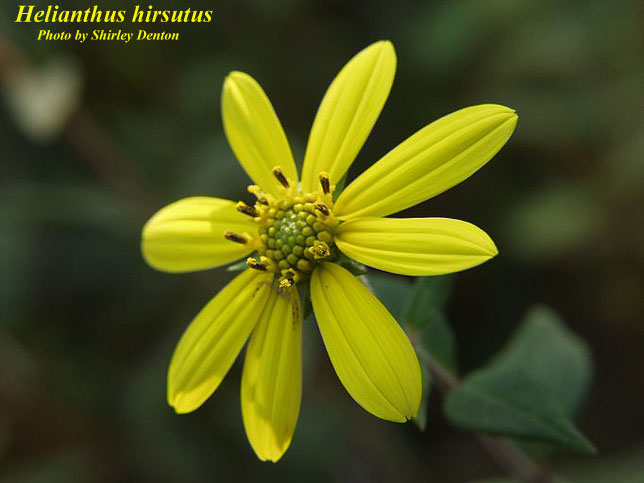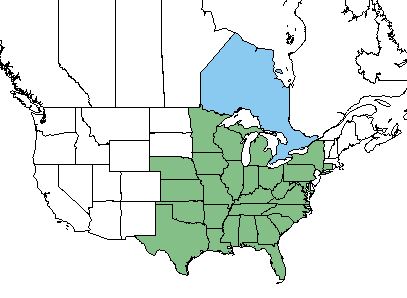Difference between revisions of "Helianthus hirsutus"
(→Conservation and Management) |
|||
| Line 33: | Line 33: | ||
''H. hirsutus'' typically grows in "woodlands and other sunny or semi-sunny habitats" <ref name="Weakley">Weakley, A. S. (2015). Flora of the Southern and Mid-Atlantic States. Chapel Hill, NC, University of North Carolina Herbarium.</ref>. It has been frequently found in ecotones at the edges of hardwood and mixed woodland forests. This species can grow in dry and moist loamy and rocky soil. It also grows in disturbed areas and areas that are burned regularly <ref name="Herbarium"> Florida State University Robert K. Godfrey Herbarium database. URL: http://herbarium.bio.fsu.edu. Last accessed: May 2018. Collectors: Loran C. Anderson, M. Morgan, Delzie Demaree, A. F. Clewell, Paul L. Redfearn Jr., Kathleen Craddock Burks, Gary R. Knight, Harry E. Ahles, J. A. Duke, R. D. Houk, Scott McCoy, Wilbur H. Duncan. W. C. Holmes, John B. Nelson, D. A. Raynerm S.W. Leonard, J. Moore, Norlan C. Henderson, George T. Jones, H.R. Bennett, D. S. Correll, H. B. Correll, Charles S. Willis, Carol L. Howel, Kevin Oakes, Richard Gaskall, J. M. Kane, Billie Bailey, Bob Farley, Brian R. Keener, R. Kral, and George Apthorp. States and Counties: Alabama: Cullman, Crenshaw, and Sumter. Arkansas: Garland, Conway, Logan and Lonoke. Florida: Clark, Jackson Leon, Gadsden, and Wakulla. Georgia: Butts, Thomas and Madison. Indiana: Harrison, Lake, Sullivan and Porter. Louisiana: Natchitoches. Missouri: Johnson, CassStone, Laclede, Greene, Douglas, and Clinton. North Carolina: Haywood and Nash. Ohio: Erie. Oklahoma: Latimer. South Carolina: Abbeville and York. Texas: Bowie and Newton. </ref>. | ''H. hirsutus'' typically grows in "woodlands and other sunny or semi-sunny habitats" <ref name="Weakley">Weakley, A. S. (2015). Flora of the Southern and Mid-Atlantic States. Chapel Hill, NC, University of North Carolina Herbarium.</ref>. It has been frequently found in ecotones at the edges of hardwood and mixed woodland forests. This species can grow in dry and moist loamy and rocky soil. It also grows in disturbed areas and areas that are burned regularly <ref name="Herbarium"> Florida State University Robert K. Godfrey Herbarium database. URL: http://herbarium.bio.fsu.edu. Last accessed: May 2018. Collectors: Loran C. Anderson, M. Morgan, Delzie Demaree, A. F. Clewell, Paul L. Redfearn Jr., Kathleen Craddock Burks, Gary R. Knight, Harry E. Ahles, J. A. Duke, R. D. Houk, Scott McCoy, Wilbur H. Duncan. W. C. Holmes, John B. Nelson, D. A. Raynerm S.W. Leonard, J. Moore, Norlan C. Henderson, George T. Jones, H.R. Bennett, D. S. Correll, H. B. Correll, Charles S. Willis, Carol L. Howel, Kevin Oakes, Richard Gaskall, J. M. Kane, Billie Bailey, Bob Farley, Brian R. Keener, R. Kral, and George Apthorp. States and Counties: Alabama: Cullman, Crenshaw, and Sumter. Arkansas: Garland, Conway, Logan and Lonoke. Florida: Clark, Jackson Leon, Gadsden, and Wakulla. Georgia: Butts, Thomas and Madison. Indiana: Harrison, Lake, Sullivan and Porter. Louisiana: Natchitoches. Missouri: Johnson, CassStone, Laclede, Greene, Douglas, and Clinton. North Carolina: Haywood and Nash. Ohio: Erie. Oklahoma: Latimer. South Carolina: Abbeville and York. Texas: Bowie and Newton. </ref>. | ||
===Phenology=== <!--Timing off flowering, fruiting, seed dispersal, and environmental triggers. Cite PanFlora website if appropriate: http://www.gilnelson.com/PanFlora/ --> | ===Phenology=== <!--Timing off flowering, fruiting, seed dispersal, and environmental triggers. Cite PanFlora website if appropriate: http://www.gilnelson.com/PanFlora/ --> | ||
| − | + | This species flowers from July through October.<ref name="Weakley"/> It has been observed to flower in July.<ref>Nelson, G. PanFlora: Plant data for the eastern United States with emphasis on the Southeastern Coastal Plains, Florida, and the Florida Panhandle. www.gilnelson.com/PanFlora/ Accessed: 21 MAY 2019</ref> | |
| − | This species flowers from July through October <ref name="Weakley"/>. | ||
<!--===Seed dispersal===--> | <!--===Seed dispersal===--> | ||
<!--===Seed bank and germination===--> | <!--===Seed bank and germination===--> | ||
Revision as of 11:36, 21 May 2019
Common names: hairy sunflower; rough sunflower; coarse sunflower; woodland sunflower
| Helianthus hirsutus | |
|---|---|

| |
| Photo by the Atlas of Florida Plants | |
| Scientific classification | |
| Kingdom: | Plantae |
| Division: | Magnoliophyta - Flowering plants |
| Class: | Magnoliopsida - Dicots |
| Order: | Asterales |
| Family: | Asteraceae |
| Genus: | Helianthus |
| Species: | H. hirsutus |
| Binomial name | |
| Helianthus hirsutus Raf. | |

| |
| Natural range of Helianthus hirsutus from USDA NRCS Plants Database. | |
Contents
Taxonomic Notes
Synonmyms: H. hirsutus Rafinesque var. hirsutus; H. hirsutus Rafinesque var. trachyphyllus Torrey & Gray; H. hirsutus Rafinesque var. stenophyllus Torrey & Gray
Description
H. hirsutus is a perennial forb that is native to the United States.[1] It reaches heights between 12 to 18 inches tall with finely toothed leaves. Leaves and stems bristly; ray flowers yellow and 1 inch in length, and disk flowers brownish to yellow in color.[2]
Distribution
While H. hirsutus is present throughout much of the United States, it is most common in the central U.S. states like Missouri, Illinois and Arkansas.[1] It's distribution is from Pennsylvania and Minnesota south to northern Florida and Texas.[3] This species has also been introduced to the canadian province of Ontario.[1]
Ecology
Habitat
H. hirsutus typically grows in "woodlands and other sunny or semi-sunny habitats" [3]. It has been frequently found in ecotones at the edges of hardwood and mixed woodland forests. This species can grow in dry and moist loamy and rocky soil. It also grows in disturbed areas and areas that are burned regularly [4].
Phenology
This species flowers from July through October.[3] It has been observed to flower in July.[5]
Fire ecology
This species can be found in areas that are burned regularly [4]. It responds positively to fire, increasing in numbers after frequent fires. [6]
Pollination
It is considered by pollination ecologists to be of special value to native bees since it attracts such large numbers for pollination.[2]
Use by animals
H. hirsutus is a much palatable species for white-tailed deer. [7]
Conservation and Management
This species is considered vulnerable in North Carolina, Virginia, Iowa, and Michigan, considered imperiled in Pennsylvania, and considered an exotic species in New York and Ontario.[8]
Cultivation and restoration
Photo Gallery
References and notes
- ↑ 1.0 1.1 1.2 USDA Plants Database URL: https://plants.usda.gov/core/profile?symbol=HEHI2
- ↑ 2.0 2.1 [[1]] Lady Bird Johnson Wildflower Center. Accessed: May 21, 2019
- ↑ 3.0 3.1 3.2 Weakley, A. S. (2015). Flora of the Southern and Mid-Atlantic States. Chapel Hill, NC, University of North Carolina Herbarium.
- ↑ 4.0 4.1 Florida State University Robert K. Godfrey Herbarium database. URL: http://herbarium.bio.fsu.edu. Last accessed: May 2018. Collectors: Loran C. Anderson, M. Morgan, Delzie Demaree, A. F. Clewell, Paul L. Redfearn Jr., Kathleen Craddock Burks, Gary R. Knight, Harry E. Ahles, J. A. Duke, R. D. Houk, Scott McCoy, Wilbur H. Duncan. W. C. Holmes, John B. Nelson, D. A. Raynerm S.W. Leonard, J. Moore, Norlan C. Henderson, George T. Jones, H.R. Bennett, D. S. Correll, H. B. Correll, Charles S. Willis, Carol L. Howel, Kevin Oakes, Richard Gaskall, J. M. Kane, Billie Bailey, Bob Farley, Brian R. Keener, R. Kral, and George Apthorp. States and Counties: Alabama: Cullman, Crenshaw, and Sumter. Arkansas: Garland, Conway, Logan and Lonoke. Florida: Clark, Jackson Leon, Gadsden, and Wakulla. Georgia: Butts, Thomas and Madison. Indiana: Harrison, Lake, Sullivan and Porter. Louisiana: Natchitoches. Missouri: Johnson, CassStone, Laclede, Greene, Douglas, and Clinton. North Carolina: Haywood and Nash. Ohio: Erie. Oklahoma: Latimer. South Carolina: Abbeville and York. Texas: Bowie and Newton.
- ↑ Nelson, G. PanFlora: Plant data for the eastern United States with emphasis on the Southeastern Coastal Plains, Florida, and the Florida Panhandle. www.gilnelson.com/PanFlora/ Accessed: 21 MAY 2019
- ↑ Sparks, J. C., et al. (1998). "Effects of late growing-season and late dormant-season prescribed fire on herbaceous vegetation in restored pine-grassland communities." Journal of Vegetation Science 9: 133-142.
- ↑ Burton, J. A. (2009). Fire frequency effects on vegetation of an upland old growth forest in eastern Oklahoma. Environmental Science. Stillwater, Oklahoma, Oklahoma State University. Bachelor: 78.
- ↑ [[2]] NatureServe Explorer. Accessed: May 21, 2019